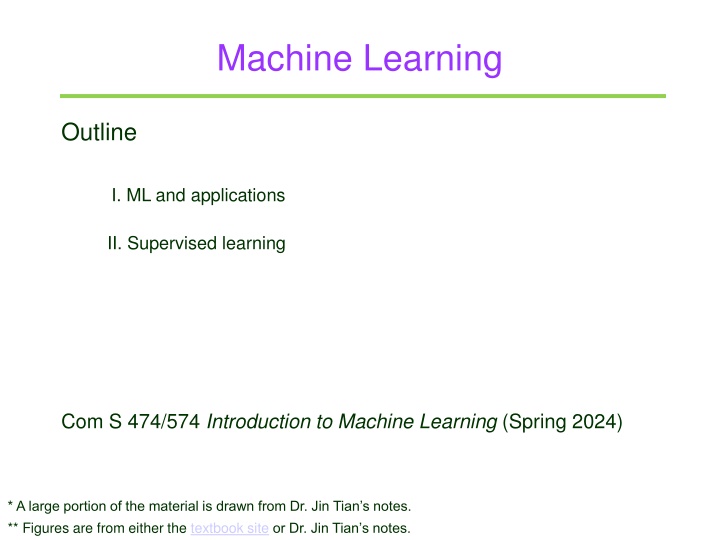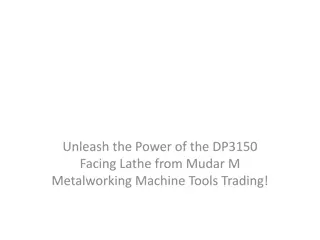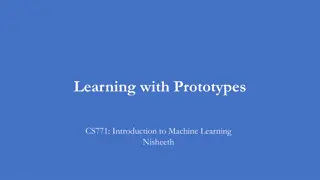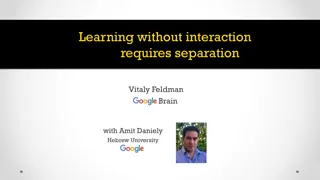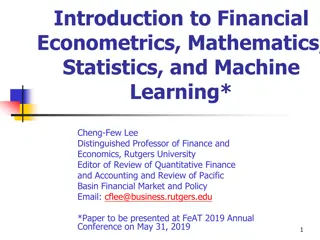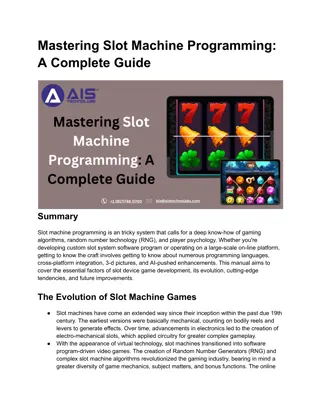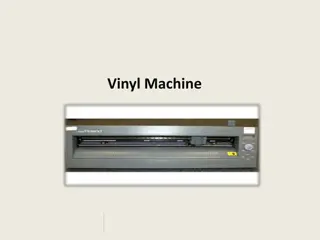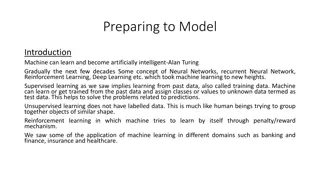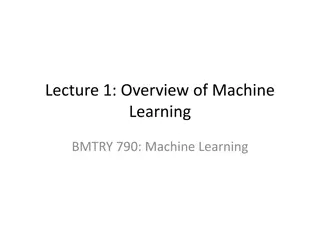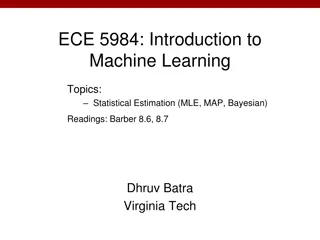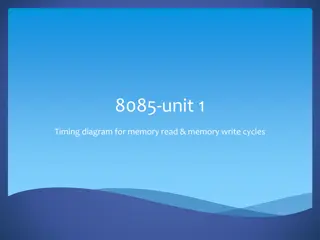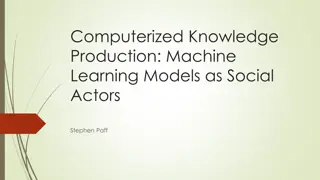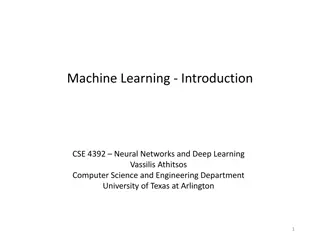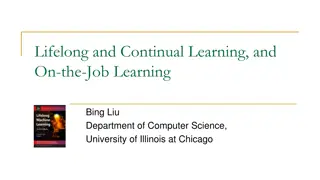Introduction to Machine Learning and Applications
This outline provides an overview of machine learning (ML) and its applications, emphasizing the role of intelligent agents, learning mechanisms, data mining, and practical examples such as predicting CPU performance. It explores how ML helps in extracting information from data, building models, and making informed decisions based on patterns in the data. The importance of learning in adapting to changing environments and unknown scenarios is highlighted.
Download Presentation

Please find below an Image/Link to download the presentation.
The content on the website is provided AS IS for your information and personal use only. It may not be sold, licensed, or shared on other websites without obtaining consent from the author.If you encounter any issues during the download, it is possible that the publisher has removed the file from their server.
You are allowed to download the files provided on this website for personal or commercial use, subject to the condition that they are used lawfully. All files are the property of their respective owners.
The content on the website is provided AS IS for your information and personal use only. It may not be sold, licensed, or shared on other websites without obtaining consent from the author.
E N D
Presentation Transcript
Machine Learning Outline I. ML and applications II. Supervised learning Com S 474/574 Introduction to Machine Learning (Spring 2024) * A large portion of the material is drawn from Dr. Jin Tian s notes. ** Figures are from either the textbook site or Dr. Jin Tian s notes.
AI and Machine Learning AI is the enterprise of design and analysis of intelligent agents. Intelligent behavior requires knowledge (e.g., model of the environment). Explicit specifications of the knowledge needed for specific tasks are hard, and often infeasible. How to acquire knowledge? Machine learning (ML) refers to the process in which a computer observes some data, builds a model based on the data, and uses the model as both a hypothesis about the world and a piece of problem solving software.
Learning Agents Learning modifies the agent s decision mechanisms to improve performance. Which component is to be improved. Which prior knowledge the agent has, which influences the model. What data and feedback on that data is available. Environment changes over time learning needs to adapt to changes. Learning is essential for unknown environments.
Applications of ML * From Wikipedia: https://en.wikipedia.org/wiki/Machine_learning#Applications
Data Mining Huge amounts of data are available from science, medicine, economics, geography, environment, sports, Data is a potentially valuable resource. Raw data are useless need techniques to automatically extract information from it. Data: recorded facts Information: patterns underlying the data Machine learning techniques automatically find patterns in data.
The Game-Weather Problem Weather condition for playing a certain game: Learned classification rules:
Learned Decision Tree tear production rate normal reduced none astigmatism no yes soft spectacle prescription hypermetrope myope none hard
Predicting CPU Performance 209 different computer configurations Function obtained through linear regression (fitting):
Image Translation Translate a horse into a zebra (find corresponding pairs):
Machine Learning Models Supervised learning Unsupervised learning Na ve Bayes classifier Nearest neighbor methods Linear models Decision trees Neural networks Support vector machines Ensemble learning Clustering: mixture models, K-means, hierarchical clustering Principal component analysis Independent component analysis Sequential data HMMs Recurrent neural networks Probabilistic graphical models Markov decision process Bayesian networks Markov random fields Reinforcement Learning
Supervised Learning The agent observes input-output pairs and learns a function that maps from input to output. Problem Given a training set of ? input-output pairs: ?1,?1, ?2,?2, , ??,?? where each pair was generated by an unknown function ? = ?(?), discover a function to approximate ?. hypothesis (or model) drawn from a hypothesis space of possible functions chosen according to some prior knowledge about data generation ?1,?2, ,??:ground truth to be predicted by our model
Best-Fit Function With noise in data, we cannot expect an exact match with the ground truth, namely, ?? = ??, for 1 ? ?. Instead, we look for a best-fit function for which each ?? is close ??. The true measure of is how it handles inputs it has not seen. Test set: a second sample of (??,??) pairs generalizes well if it matches the test set with high accuracy.
Fitting (Least-squares fitting: https://faculty.sites.iastate.edu/jia/files/inline-files/data-fit.pdf) 13 points fitting becomes interpolation 12 ?? = ??1? + ??0, 1 ? 12 such that ???+1 = ?+1??+1 for 1 ? 11. ???? ? = ?1? + ?0 ? = ? = ?1? + sin(?0?) ?=0
Underfitting, Variance & Overfitting A hypothesis is underfitting when it fails to find a pattern in the data. Such a hypothesis has high bias and low variance. Variance characterizes the amount of change in the hypothesis due to fluctuation in the training data. A hypothesis is overfitting when it pays too much attention to the particular training set. Such a hypothesis has low bias and high variance. High variance Overfitting Overfitting Underfitting (possibly)
Best Hypothesis It depends on what we knew was represented by the data, or, what we were expecting from the data ... Choosing the hypothesis that is most probable given the data: ? data) = arcmax ? data )?( ) = arcmax (Bayes rule) A simple hypothesis space is often preferred: The more expressiveness of , the higher the computational cost of finding a good hypothesis within that space. We will likely be using for evaluations after we have learned it.
Restaurant Waiting Problem Decide whether to wait for a table at a restaurant. Output: a Boolean variable WillWait (true where we do wait for a table). Input: a vector of ten attributes, each with discrete values: 1. Alternate: whether there is a suitable alternative restaurant nearby. 2. Bar: whether the restaurant has a comfortable bar area to wait in. 3. Fri/Sat: true on Fridays and Saturdays. 4. Hungry: whether we are hungry right now. 5. Patrons: how many people are in the restaurant (values: None, Some, and Full). 6. Price: the restaurant s price range ($, $$, $$$). 7. Raining: whether it is raining outside. 8. Reservation: whether we made a reservation. 9. Type: the kind of restaurant (French, Italian, Thai, or burger). 10. WaitEstimate: host s wait estimate: 0-10, 10-30, 30-60, or >60 minutes. 26 32 42= 9,216 possible combinations of attribute values.
Training Examples The correct output is given for only 12 out of 9,216 examples. We need to make our best guess at the missing 9,204 output values.
